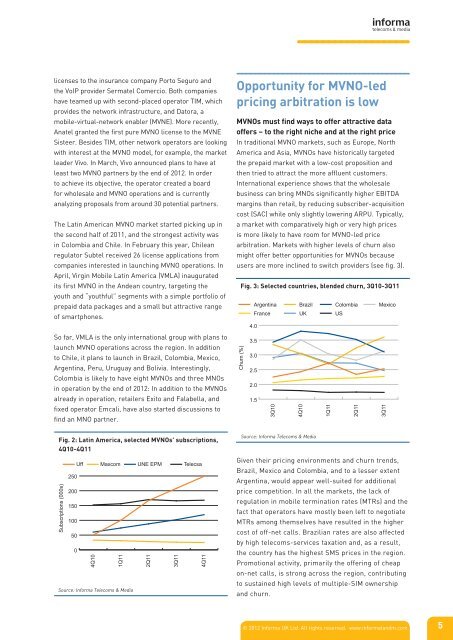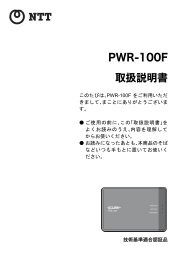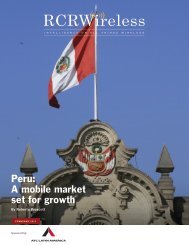Create successful ePaper yourself
Turn your PDF publications into a flip-book with our unique Google optimized e-Paper software.
licenses to the insurance company Porto Seguro and<br />
the VoIP provider Sermatel Comercio. Both companies<br />
have teamed up with second-placed operator TIM, which<br />
provides the network infrastructure, and Datora, a<br />
mobile-virtual-network enabler (MVNE). More recently,<br />
Anatel granted the first pure <strong>MVNO</strong> license to the MVNE<br />
Sisteer. Besides TIM, other network operators are looking<br />
with interest at the <strong>MVNO</strong> model, for example, the market<br />
leader Vivo. In March, Vivo announced plans to have at<br />
least two <strong>MVNO</strong> partners by the end <strong>of</strong> 2012. In order<br />
to achieve its objective, the operator created a board<br />
for wholesale and <strong>MVNO</strong> operations and is currently<br />
analyzing proposals from around 30 potential partners.<br />
<strong>The</strong> Latin American <strong>MVNO</strong> market started picking up in<br />
the second half <strong>of</strong> 2011, and the strongest activity was<br />
in Colombia and Chile. In February this year, Chilean<br />
regulator Subtel received 26 license applications from<br />
companies interested in launching <strong>MVNO</strong> operations. In<br />
April, Virgin Mobile Latin America (VMLA) inaugurated<br />
its first <strong>MVNO</strong> in the Andean country, targeting the<br />
youth and “youthful” segments with a simple portfolio <strong>of</strong><br />
prepaid data packages and a small but attractive range<br />
<strong>of</strong> smartphones.<br />
So far, VMLA is the only international group with plans to<br />
launch <strong>MVNO</strong> operations across the region. In addition<br />
to Chile, it plans to launch in Brazil, Colombia, Mexico,<br />
Argentina, Peru, Uruguay and Bolivia. Interestingly,<br />
Colombia is likely to have eight <strong><strong>MVNO</strong>s</strong> and three MNOs<br />
in operation by the end <strong>of</strong> 2012: In addition to the <strong><strong>MVNO</strong>s</strong><br />
already in operation, retailers Exito and Falabella, and<br />
fixed operator Emcali, have also started discussions to<br />
find an MNO partner.<br />
Opportunity for <strong>MVNO</strong>-led<br />
pricing arbitration is low<br />
<strong><strong>MVNO</strong>s</strong> must find ways to <strong>of</strong>fer attractive data<br />
<strong>of</strong>fers – to the right niche and at the right price<br />
In traditional <strong>MVNO</strong> markets, such as Europe, North<br />
America and Asia, <strong><strong>MVNO</strong>s</strong> have historically targeted<br />
the prepaid market with a low-cost proposition and<br />
then tried to attract the more affluent customers.<br />
International experience shows that the wholesale<br />
business can bring MNOs significantly higher EBITDA<br />
margins than retail, by reducing subscriber-acquisition<br />
cost (SAC) while only slightly lowering ARPU. Typically,<br />
a market with comparatively high or very high prices<br />
is more likely to have room for <strong>MVNO</strong>-led price<br />
arbitration. Markets with higher levels <strong>of</strong> churn also<br />
might <strong>of</strong>fer better opportunities for <strong><strong>MVNO</strong>s</strong> because<br />
users are more inclined to switch providers (see fig. 3).<br />
Churn (%)<br />
Fig. 3: Selected countries, blended churn, 3Q10-3Q11<br />
4.0<br />
3.5<br />
3.0<br />
2.5<br />
2.0<br />
1.5<br />
Argentina Brazil Colombia Mexico<br />
France UK US<br />
3Q10<br />
4Q10<br />
1Q11<br />
2Q11<br />
3Q11<br />
Fig. 2: Latin America, selected <strong><strong>MVNO</strong>s</strong>' subscriptions,<br />
4Q10-4Q11<br />
Source: Informa Telecoms & Media<br />
Uff<br />
250<br />
Maxcom<br />
UNE EPM<br />
Telecsa<br />
Given their pricing environments and churn trends,<br />
Brazil, Mexico and Colombia, and to a lesser extent<br />
Argentina, would appear well-suited for additional<br />
Subscriptions (000s)<br />
200<br />
150<br />
100<br />
50<br />
0<br />
4Q10<br />
1Q11<br />
2Q11<br />
3Q11<br />
4Q11<br />
price competition. In all the markets, the lack <strong>of</strong><br />
regulation in mobile termination rates (MTRs) and the<br />
fact that operators have mostly been left to negotiate<br />
MTRs among themselves have resulted in the higher<br />
cost <strong>of</strong> <strong>of</strong>f-net calls. Brazilian rates are also affected<br />
by high telecoms-services taxation and, as a result,<br />
the country has the highest SMS prices in the region.<br />
Promotional activity, primarily the <strong>of</strong>fering <strong>of</strong> cheap<br />
on-net calls, is strong across the region, contributing<br />
Source: Informa Telecoms & Media<br />
to sustained high levels <strong>of</strong> multiple-SIM ownership<br />
and churn.<br />
© 2012 Informa UK Ltd. All rights reserved. www.informatandm.com 5
















